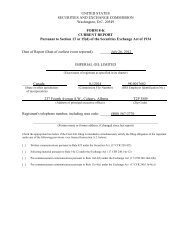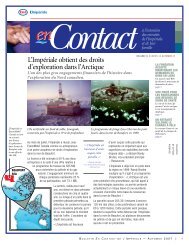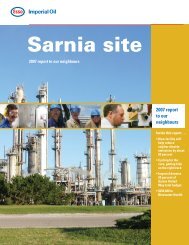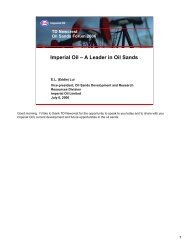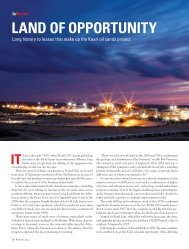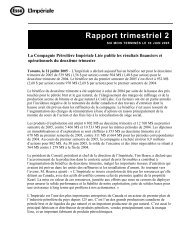FORM 10-K IMPERIAL OIL LIMITED
FORM 10-K IMPERIAL OIL LIMITED
FORM 10-K IMPERIAL OIL LIMITED
Create successful ePaper yourself
Turn your PDF publications into a flip-book with our unique Google optimized e-Paper software.
operating methods) applied to (3) the asset cost. The volumes produced and asset cost are known and<br />
while proved developed reserves have a high probability of recoverability, they are based on estimates<br />
that are subject to some variability. This variability has generally resulted in net upward revisions of proved<br />
reserves in existing fields, as more information becomes available through research and production.<br />
Revisions have averaged 16 million oil equivalent barrels per year over the last five years and have resulted<br />
from effective reservoir management and the application of new technology. While the upward revisions the<br />
Company has made over the last five years are an indicator of variability, they have had little impact on the<br />
unit of production rates of depreciation because they have been small compared to the large proved<br />
reserves base.<br />
Impact of reserves and prices on testing for impairment<br />
Proved oil and gas properties held and used by the Company are reviewed for impairment whenever<br />
events or circumstances indicate that the carrying amounts may not be recoverable. Assets are grouped at<br />
the lowest level for which there are identifiable cash flows that are largely independent of the cash flows of<br />
other groups of assets.<br />
The Company estimates the future undiscounted cash flows of the affected properties to judge the<br />
recoverability of carrying amounts. In general, impairment analyses are based on proved reserves. Where<br />
probable reserves exist, an appropriately risk adjusted amount of these reserves may be included in the<br />
impairment evaluation. An asset would be impaired if the undiscounted cash flows were less than its<br />
carrying value. Impairments are measured by the amount by which the carrying value exceeds its fair value.<br />
The impairment evaluation triggers include a significant decrease in current and projected prices or<br />
reserve volumes, an accumulation of project costs significantly in excess of the amount originally expected,<br />
and historical and current negative operating losses.<br />
In general, the Company does not view temporarily low oil prices as a triggering event for conducting<br />
the impairment tests. The markets for crude oil and natural gas have a history of significant price volatility.<br />
Although prices will occasionally drop precipitously, the relative growth/decline in supply versus demand will<br />
determine industry prices over the long term and these cannot be accurately predicted. Accordingly, any<br />
impairment tests that the Company performs make use of the Company’s long term price assumptions for the<br />
crude oil and natural gas markets, petroleum products and chemicals. These are the same price assumptions<br />
that are used in the Company’s annual planning and budgeting processes and are also used for capital<br />
investment decisions.<br />
The standardized measure of discounted future cash flows on page 30 is based on the year end 2004<br />
price applied for all future years, as required under Statement of Financial Accounting Standards No. 69<br />
(SFAS 69). Future prices used for any impairment tests will vary from the one used in the SFAS 69<br />
disclosure, and could be lower or higher for any given year.<br />
Retirement benefits<br />
The Company’s pension plan is managed in compliance with the requirements of governmental<br />
authorities and meets funding levels as determined by independent third party actuaries. Pension<br />
accounting requires explicit assumptions regarding, among others, the discount rate for the benefit<br />
obligations, the expected rate of return on plan assets and the long term rate of future compensation<br />
increases. All pension assumptions are reviewed annually by senior management. These assumptions<br />
are adjusted only as appropriate to reflect long term changes in market rates and outlook. The long term<br />
expected rate of return on plan assets of 8.25 percent used in 2004 compares to actual returns of <strong>10</strong>.7<br />
percent and <strong>10</strong>.1 percent achieved over the last <strong>10</strong> and 20 year periods ending December 31, 2004. If<br />
different assumptions are used, the expense and obligations could increase or decrease as a result. The<br />
Company’s potential exposure to changes in assumptions is summarized in note 7 to the consolidated<br />
financial statements on page F-13. At the Company, differences between actual returns on plan assets<br />
versus long term expected returns are not recorded in the year the differences occur, but rather are<br />
amortized in pension expense as permitted by GAAP, along with other actuarial gains and losses over the<br />
expected remaining service life of employees. The Company uses the fair value of the plan assets at year<br />
end to determine the amount of the actual gain or loss that will be amortized and does not use a moving<br />
average value of plan assets. Pension expense represented about one percent of total expenses in 2004.<br />
Asset retirement obligations and other environmental liabilities<br />
Legal obligations associated with site restoration on the retirement of assets with determinable useful<br />
lives are recognized when they are incurred, which is typically at the time the assets are installed. The<br />
obligations are initially measured at fair value and discounted to present value. Over time, the discounted<br />
asset retirement obligation amount will be accreted for the change in its present value, with this effect<br />
included in operating expense. As payments to settle the obligations occur on an ongoing basis and will<br />
continue over the lives of the operating assets, which can exceed 25 years, the discount rate will be<br />
adjusted only as appropriate to reflect long term changes in market rates and outlook. For 2004, the<br />
obligations were discounted at six percent and the accretion expense was $22 million, which was<br />
significantly less than one percent of total expenses in the year. There would be no material impact<br />
on the Company’s reported financial results if a different discount rate had been used.<br />
25



